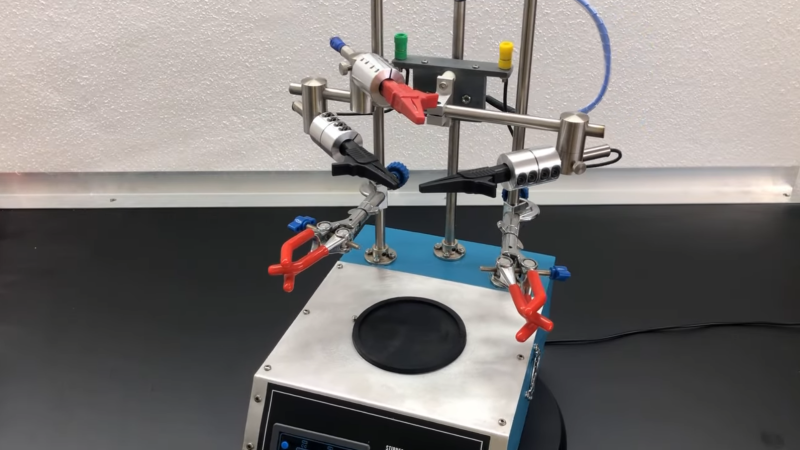We don’t get enough electrochemistry hacks on these pages, so here’s [Markus Bindhammer] of YouTube/Marb’s lab fame to give us a fix with their hand-built general-purpose electrochemistry device.
The basic structure is made from plyboard cut to size on a table saw and glued’n’screwed together. The top and front are constructed from an aluminium sheet bent to shape with a hand-bender. A laser-printed front panel finishes the aesthetic nicely, contrasting with the shiny aluminium. The electrode holders are part of off-the-shelf chemistry components, with the electrical contacts hand-made from components usually used for constructing stair handrails. Inside, a 500 RPM 12 V DC geared motor is mounted, driving a couple of small magnets. A PWM motor speed controller provides power. This allows a magnetic stirrer to be added for relevant applications. Power for the electrochemical cell is courtesy of a Zk-5KX buck-boost power supply with a range of 0 – 36 V at up to 5 A with both CV and CC modes. A third electrode holder is also provided as a reference electrode for voltammetry applications. A simple and effective build, we reckon!
Over the years, we’ve seen a few electrochemical hacks, like this DIY electroplating pen, a DIY electrochemical machining rig, and finally, a little something about 3D printing metal electrochemically.
















I am surprised to see only one container. Electrochemical Cells are a big part of Electro-Chemistry studies and almost always have at least two containers.[1]
[One] Electrochemical Cells
https://ch302.cm.utexas.edu/echem/selector.php?name=echem-cells
There are a large number of electrochemical cells combined in one jar: https://redox.me/collections/electrochemical-cells
Exact ones I’ve been using for years on vacuum distillation setups – the ones that sit at a fixed length/angle their whole life are fine, while the ones that need to be adjusted for each setup fail to lock properly. I blame the zamak vs steel thread surfaces and premature wear.
Could be a difference in manufacture lots and/or use cases. To each their own I suppose.
@Markus Bindhammer said: “There are a large number of electrochemical cells combined in one jar: https://redox.me/collections/electrochemical-cells”
These folks at Pine make something called “EChem in a Box”:
https://pineresearch.com/shop/product-category/applications/echem-in-a-box/
Example: Hydrogen Permeation Cell
https://pineresearch.com/shop/products/applications/corrosion-products/hydrogen-permeation-cell/
Thanks for the link. Looks very interesting.
To anyone who might do this – that style of three-finger clamp SUCKS – they’ll only stay put once, poor design and materials – go for the old-school pinched-rod and spend a couple bucks to guarantee you’re getting steel vs pot metal.
I cannot confirm this, I have been working with these three-finger clamps for many years and have never had any problems. The three-finger clamps are from StonyLab: https://stonylab.com/products/b07xfd6szq-3-prong-single-adjust-clamp
Have you considered combing this work with the Four Thieves Vinegar Collective’s microlab? They have a full toolchain that you can even make recipes, and trade them with others. That means only 1 person needs to do the hard chemistry work, and others can simply go through the motions!
Open Source chemistry!
https://fourthievesvinegar.org/microlab-suite/
Thanks for the link. Looks very interesting. However, the biggest hurdle for amateur chemists is still to buy the appropriate chemicals.
So… thats actually being worked on as well! Four Thieves also has https://synth.fourthievesvinegar.org/ which is ChemHacktica. That’s primarily for organic synthesis of existing pharmeceuticals… BUT they also include legality, cost, and where to buy chemical reagents.
There’s also a virtual research assistant “Vinni”, that you can ask chemistry based questions and processes.
From what I’ve looked at this ecosystem, seems like it would be a great jumping-off-point to work together and make a comprehensive chemistry system that can automate and walk you through the non-automatable parts!
Speaking of automation, I while ago I built an auto sample, but haven’t had time to use it yet: https://www.youtube.com/watch?v=r058XATmq3Y
Thanks again to pointing this out!
Now to take my rather rusty high school chemistry skills, build this wonderful device, and start making my own 85% H2O2 rocket fuel…. and take out a loan to buy enough high end catalyst material to use it.